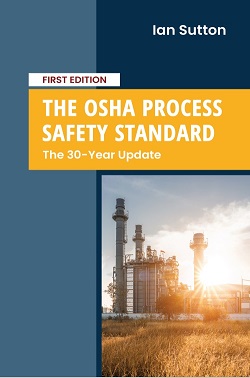
Welcome
Welcome to Sutton Technical Books. We provide books, ebooks, videos and topical information for managers, engineers and executives in the process and energy industries. Our goal is to provide practical information that will help you design and operate facilities that are safe, efficient and in compliance with rules and regulations. We also provide information for managers who are developing or implementing ‘Net Zero by 2050’ programs.
We provide books, ebooks, videos, primers, and blog posts covering the following topics:
Process Safety Management
Design of Energy and Process Facilities
Operation of Energy and Process Facilities
Net Zero by 2050
Offshore Safety
Faith in a Changing Climate
Recent Publications
The following books and blog posts are recent releases.
Process Safety Management

This book provides a comprehensive, practical and readable description of the topic of process safety management. It has 21 chapters. It can be purchased here.
Chapter 1 - The Process Safety Discipline
Chapter 2 - Risk Analysis and Management
Chapter 3 - Regulations and Standards
Chapter 4 - Process Safety Culture
Chapter 5 - Process Safety Information
Chapter 6 - Hazards Analysis
Chapter 7 - Consequence Analysis
Chapter 8 - Frequency Analysis
Chapter 9 - Operating Procedures
Chapter 10 - Training and Human Factors
Chapter 11 - Contractor Management
Chapter 12 - Asset Integrity and Maintenance
Chapter 13 - Operational Readiness
Chapter 14 - Management of Change
Chapter 15 - Incident Investigation and Analysis
Chapter 16 - Emergency Response
Chapter 17 - Audits and Reviews
Chapter 18 - Reliability, Availability and Maintainability
Chapter 19 - Safety in Design
Chapter 20 - Managing a Process Safety Program
Chapter 21 - The Process Safety Professional
All models are wrong, but some are useful
This post at the Process Safety Report site discusses the values and limitations of models. A related post at the Net Zero site is The Value of Models / How to Use Models Without Believing in Them
The OSHA Process Safety Standard: The 30-Year Update

In August 2022 the United States Occupational Safety and Health Administration stated that they intended to update their Process Safety Management standard (29 CFR 1910.119). At a Stakeholder Meeting held in October of that year they listed some of the areas that they would like to update. There were 24 proposed updates in total. We have a written a series of posts describing each of these updates and providing some commentary on them. An index for all of these posts is provided here.
The contents of these posts, along with additional material, are now available in the book The OSHA Process Safety Standard: The 30-Year Update. Order information is provided here. The book is priced at $25 (U.S.).
Copyright © Ian Sutton. 2026. All Rights Reserved.